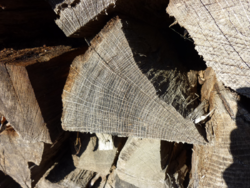Good morning,
I finally got my Ideal Steel installed this week and am having a problem with it. I think I know the cause but wanted to get input.
I bought 4 cords of "seasoned" firewood early October. I know the wood is not ideal, I could tell from the weight of some of them and ended up buying a meter to test. I've had from mid teens all the way to high twenties, with the vast majority I tested landing around 22-23%.
The first fire I had in it was beautiful. Lots of secondaries, and the cat glowing red hot when throttling down the air control. The following two nights, I could not get secondaries at all, and only flames if I had the bypass open; as soon as the cat was closed in, the flames would drop, even with the air control wide open. Both mornings, there was mostly just ash left with some hot coals remaining so it did eventually burn down.
Here's my question. The wood used in the first fire had been inside on our rack for about a month. The following two nights the wood was from outside. Would a month of being inside had dried out the wood enough to make that difference, or is there something else going on?
I ended up buying couple of bundles of kiln dried from Home Depot to test, but we're having a warm front come through and it is in the low 60s with heavy rains - besides not wanting to burn us out of the house, I want to test the dry wood under similar conditions.
I'm hoping that it's the fact the wood isn't seasoned well enough, and a month inside made the difference for the first batch.
Thank you!
I finally got my Ideal Steel installed this week and am having a problem with it. I think I know the cause but wanted to get input.
I bought 4 cords of "seasoned" firewood early October. I know the wood is not ideal, I could tell from the weight of some of them and ended up buying a meter to test. I've had from mid teens all the way to high twenties, with the vast majority I tested landing around 22-23%.
The first fire I had in it was beautiful. Lots of secondaries, and the cat glowing red hot when throttling down the air control. The following two nights, I could not get secondaries at all, and only flames if I had the bypass open; as soon as the cat was closed in, the flames would drop, even with the air control wide open. Both mornings, there was mostly just ash left with some hot coals remaining so it did eventually burn down.
Here's my question. The wood used in the first fire had been inside on our rack for about a month. The following two nights the wood was from outside. Would a month of being inside had dried out the wood enough to make that difference, or is there something else going on?
I ended up buying couple of bundles of kiln dried from Home Depot to test, but we're having a warm front come through and it is in the low 60s with heavy rains - besides not wanting to burn us out of the house, I want to test the dry wood under similar conditions.
I'm hoping that it's the fact the wood isn't seasoned well enough, and a month inside made the difference for the first batch.
Thank you!
Last edited:


 Mine wasn't thrilled, but she let it slide since I was getting her more heat.
Mine wasn't thrilled, but she let it slide since I was getting her more heat. 

 4" on a side isn't too bad but you might need bigger splits, depending on your stove type and setup (if you need to slow down the burn.)
4" on a side isn't too bad but you might need bigger splits, depending on your stove type and setup (if you need to slow down the burn.)